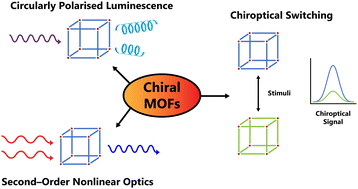Chiral metal–organic frameworks for photonics
Abstract
Recently, there has been significant interest in the use of chiral metal–organic frameworks (MOFs) and coordination polymers (CPs) for photonics applications. The promise of these materials lies in the ability to tune their properties through judicious selection of the metal and ligand components. Additionally, the interaction of guest species with the host framework can be exploited to realise new functionalities. In this review, we outline the methods for synthesising chiral MOFs and CPs, then analyse the recent innovations in their use for various optical and photonics applications. We focus on two emerging directions in the field of MOF chemistry – circularly polarised luminescence (CPL) and chiroptical switching – as well as the latest developments in the use of these materials for second-order nonlinear optics (NLO), particularly second-harmonic generation (SHG). The current challenges encountered so far, their possible solutions, and key directions for further research are also outlined. Overall, given the results demonstrated to date, chiral MOFs and CPs show great promise for use in future technologies such as optical communication and computing, optical displays, and all-optical devices.



 Please wait while we load your content...
Please wait while we load your content...